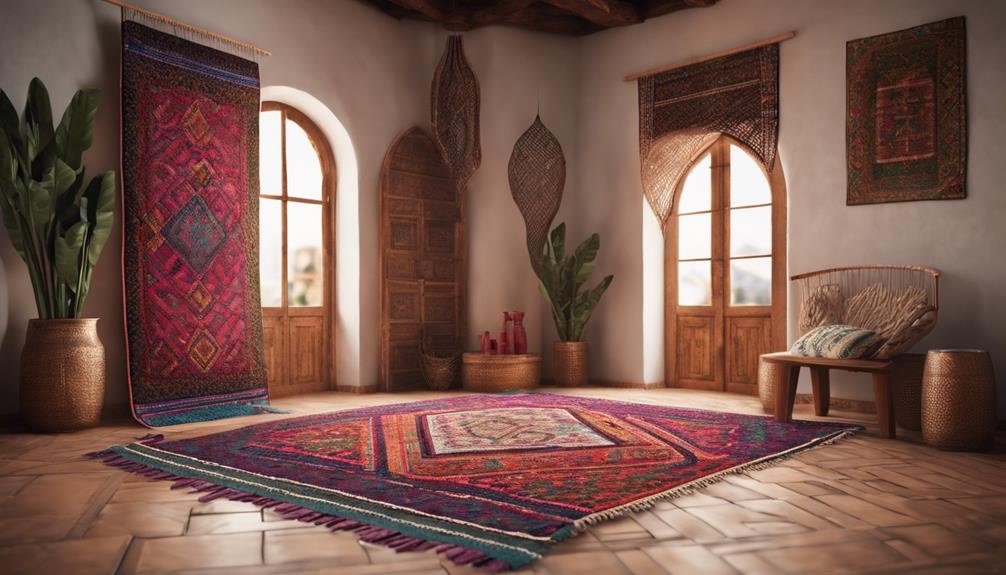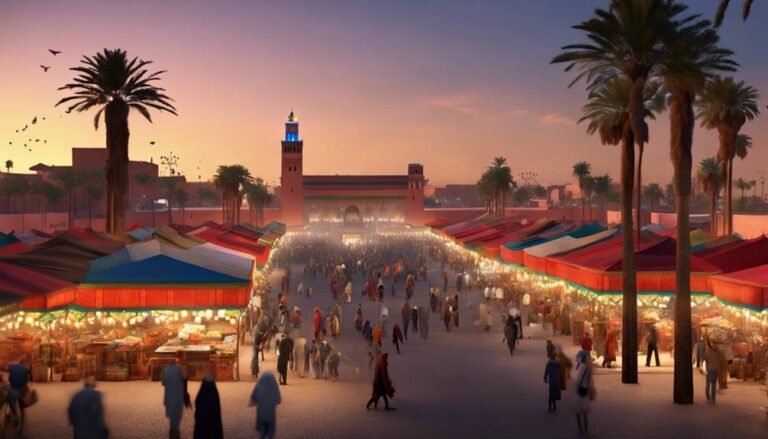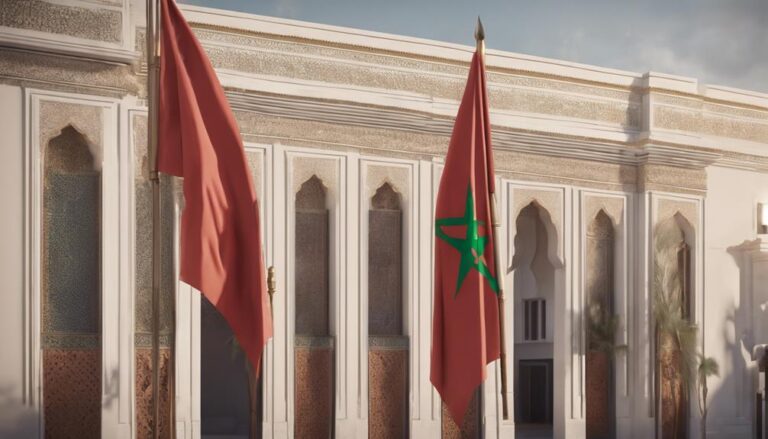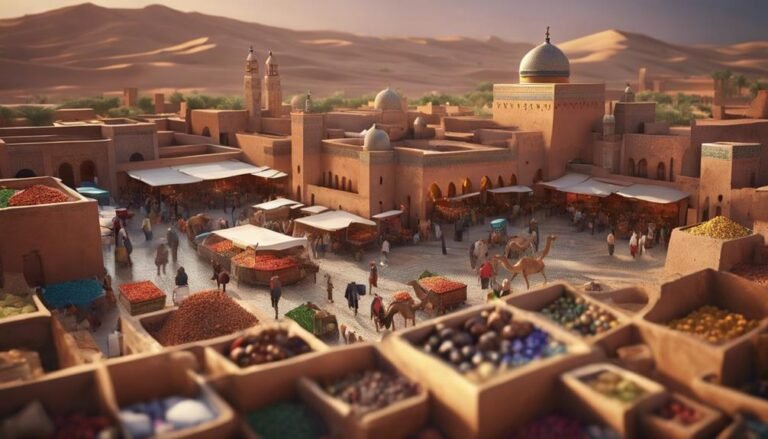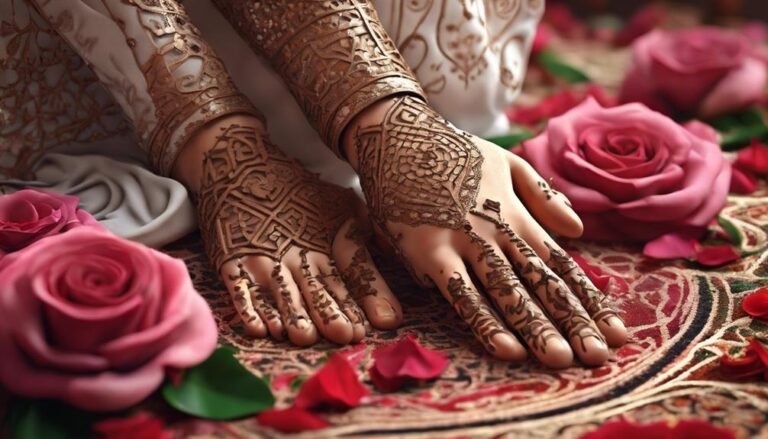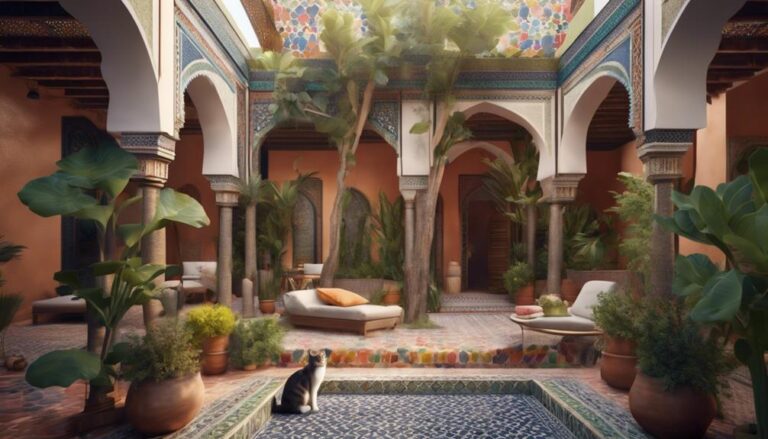Moroccan Carpets originate from ancient Berber tribes, reflecting rich cultural heritage and traditional craftsmanship. Weaving techniques vary by region, showcasing unique design influences. These carpets employ natural dye sources, incorporating distinctive motifs inspired by nature, geometry, and tradition. Crafted using wool or cotton with intricate weaving methods like the Berber knot, each carpet symbolizes deep cultural significance. Tools and techniques, along with color symbolism, highlight the artistry behind these pieces. Different regions contribute diverse influences to designs and techniques, creating a tapestry of cultural expressions. Discover the mesmerizing world of Moroccan Carpets and unravel the stories they hold.
Key Takeaways
- Moroccan Carpets are woven by artisans using traditional techniques like the Berber knot and flatweave methods.
- They feature distinct designs inspired by nature, geometric shapes, and traditional symbols.
- Crafted from wool, cotton, or a blend, these carpets showcase rich cultural heritage and intricate weaving.
- Natural dye sources provide a vibrant color palette, reflecting deep cultural significance in every knot.
- Each carpet embodies regional influences, with diverse weaving techniques and unique design motifs.
Origins of Moroccan Carpets
Moroccan Carpets trace their origins back to ancient Berber tribes in North Africa, showcasing a rich cultural heritage and traditional craftsmanship. These carpets have a deep historical significance, with roots dating back centuries. The Berber tribes, known for their nomadic lifestyle, began weaving these carpets as a practical necessity to protect against the harsh desert climates. Over time, this craft evolved into an art form, reflecting the artistic evolution of the Berber people.
The cultural significance of Moroccan Carpets lies in the intricate designs and symbols woven into each piece. These motifs often carry specific meanings related to Berber traditions, beliefs, and daily life. The artistic evolution of Moroccan Carpets can be seen in the incorporation of modern influences. While traditional patterns and techniques are still prevalent, contemporary designs have also emerged, blending the old with the new to cater to diverse tastes and trends. This amalgamation of historical origins and modern influences has helped Moroccan Carpets maintain their allure and relevance in today's global market.
Types of Moroccan Carpet Weaving
As you explore the diverse world of Moroccan carpet weaving, you'll encounter a rich tapestry of weaving techniques employed by different regions.
These techniques not only showcase the craftsmanship but also reflect the unique design influences of each area.
Understanding the intricate blend of weaving styles and regional motifs is essential in unraveling the history and artistry behind Moroccan carpets.
Weaving Techniques
Traditional Moroccan carpets showcase a rich tapestry of weaving techniques that have been passed down through generations, each method contributing to the unique beauty and quality of these intricate pieces. Ancient techniques like the Berber knot and the flatweave method are still used today, with modern adaptations to meet contemporary demands.
The Berber knot, a distinctive feature of Moroccan rugs, creates a plush pile that's both durable and visually striking. These weaving techniques not only serve functional purposes but also hold deep cultural symbolism, reflecting the history and traditions of Moroccan craftsmanship.
In recent times, there's been a resurgence of interest in traditional weaving methods, blending cultural heritage with contemporary trends to create carpets that are both timeless and stylish.
Regional Design Influences
Weaving techniques in Moroccan carpets serve as the foundation for understanding the diverse regional design influences that shape the various types of Moroccan carpet weaving. Throughout history, Moroccan carpets have been influenced by a rich tapestry of cultural exchanges and evolutions, leading to unique styles in different regions. Below is a table highlighting some of the prominent types of Moroccan carpet weaving influenced by regional design elements:
| Region | Design Influences | Characteristics |
|---|---|---|
| Atlas Mountains | Berber tribal patterns | Bold geometric motifs |
| Rabat | Islamic art motifs | Intricate floral designs |
| Marrakech | Andalusian influences | Vibrant colors and intricate patterns |
| Fez | Ottoman influences | Complex patterns and rich colors |
| Meknes | French colonial influences | Symmetrical and elegant designs |
Materials Used in Moroccan Carpets
When crafting Moroccan carpets, artisans meticulously employ traditional weaving techniques that have been passed down through generations, ensuring the rugs' authenticity and durability.
The materials used in these carpets often come from natural dye sources found in the surrounding landscape, creating a rich and vibrant color palette that's unique to Moroccan textiles.
Each carpet features distinctive design motifs that reflect the cultural heritage and artistic traditions of the region, making every piece a symbol of Moroccan craftsmanship and creativity.
Traditional Weaving Techniques
Utilizing a complex blend of natural materials sourced locally, Moroccan artisans intricately craft their carpets with time-honored techniques passed down through generations.
The traditional weaving techniques involve a meticulous process where skilled craftsmen intertwine wool, cotton, or sometimes a mix of both to form intricate patterns and designs. These techniques have evolved over centuries, adapting to modern tools while preserving their cultural significance.
Each knot and weave in a Moroccan carpet tells a story, reflecting the artisan's expertise and the region's heritage. The weavers often incorporate geometric shapes, symbols, and colors that hold symbolic meanings within Moroccan culture.
Natural Dye Sources
Drawing from a rich array of natural sources, Moroccan carpet makers derive their dyes from plants, minerals, and insects indigenous to the region, infusing each creation with a palette rooted in the land's diverse offerings.
Natural dye techniques have been passed down through generations, emphasizing sustainability and eco-friendliness. The cultural significance of these dye sources lies in their historical context, where the art of dyeing has been intertwined with Moroccan culture for centuries.
Plants like saffron, indigo, and henna provide a spectrum of colors, while minerals such as iron and copper offer earthy tones. Insects like cochineal beetles contribute to vibrant reds. By harnessing these natural resources, Moroccan carpet weavers not only create stunning designs but also uphold a tradition deeply connected to their heritage.
Unique Design Motifs
Derived from the vibrant natural dye sources of the region, Moroccan carpets showcase a myriad of unique design motifs crafted from an array of traditional materials.
Symbolic motifs in Moroccan carpets often carry deep cultural significance, reflecting the beliefs, history, and traditions of the Berber tribes who've been weaving these carpets for generations. These motifs can include geometric patterns, symbols of protection, and representations of daily life.
Modern interpretations of these traditional designs have also emerged, blending the old with the new to create contemporary trends in carpet weaving.
Through intricate weaving techniques and a rich tapestry of symbols, Moroccan carpets continue to captivate with their timeless beauty and cultural storytelling.
Traditional Moroccan Carpet Designs
Traditional Moroccan Carpet Designs showcase a rich tapestry of intricate patterns and vibrant colors that reflect the cultural heritage and artistic traditions of Morocco. These designs aren't just beautiful creations but hold deep cultural significance, serving as a form of artistic expression for the Moroccan people. The patterns found in these carpets often draw inspiration from nature, geometric shapes, and traditional symbols that have been passed down through generations.
Despite the traditional techniques used in creating these carpets, there are also modern interpretations that blend contemporary styles with the classic designs. The intricate motifs and bold colors found in Moroccan carpets are a tribute to the skilled craftsmanship of the weavers who meticulously create each piece by hand. Each design tells a story, whether it be a representation of a specific tribe, a symbol of protection, or a reflection of the weaver's emotions at the time of creation.
The fusion of traditional methods with artistic innovation makes Moroccan carpet designs truly timeless and cherished pieces of art.
Process of Making Moroccan Carpets
The intricate process of crafting Moroccan carpets involves a meticulous blend of ancient weaving techniques and artistic ingenuity, resulting in exquisite pieces that embody the cultural heritage of Morocco. The history and evolution of Moroccan carpet making date back centuries, with each carpet telling a unique story through its patterns and symbols. These carpets hold deep cultural significance, often symbolizing protection, fertility, or tribal affiliations. The craft of carpet making in Morocco has been passed down through generations, with weavers using traditional methods that have stood the test of time.
The process begins with sourcing high-quality wool or cotton, which is then dyed using natural pigments to achieve the vibrant colors typical of Moroccan carpets. Skilled artisans then meticulously hand-weave the carpet on a loom, incorporating intricate geometric patterns or symbolic motifs that reflect Morocco's diverse cultural influences. The weaving process can take weeks or even months to complete, depending on the size and complexity of the design. Each knot and weave is a proof of the artistry and craftsmanship that goes into creating these timeless pieces.
Tools and Techniques in Carpet Making
Crafting Moroccan carpets involves the utilization of specialized tools and weaving techniques that have been refined over centuries, contributing to the intricacy and cultural richness of each piece. Moroccan carpet weavers use a traditional vertical loom setup, consisting of a sturdy frame with the warp threads stretched vertically. This setup allows for the creation of intricate patterns and designs.
The knotting process is an essential step in carpet making, with the two primary knotting techniques being the symmetrical (Ghiordes) knot and the asymmetrical (Senneh) knot. Weavers meticulously tie each knot by hand, creating the pile of the carpet. The density and tightness of the knots determine the durability and quality of the carpet.
Additionally, specialized tools such as a comb-like beater and shears are used to pack down the rows of knots and trim the pile to achieve a uniform surface. These tools and techniques are essential in preserving the artistry and authenticity of Moroccan carpets.
Significance of Colors in Moroccan Carpets
In the vibrant world of Moroccan carpets, colors play a pivotal role, embodying cultural symbolism and historical significance in each intricately woven masterpiece. The rich hues found in Moroccan carpets aren't just a visual treat; they carry deep meanings that reflect the traditions and beliefs of the weavers.
Each color used in these carpets holds symbolic value, with red symbolizing strength and protection, blue representing wisdom and peacefulness, green signifying life and paradise, and yellow embodying eternity and wealth. These colors are often incorporated into intricate geometric patterns that have been passed down through generations, each design telling a story or conveying a specific message.
The cultural significance of these colors is profound, connecting the carpets to the heritage and identity of the Moroccan people. By understanding the symbolism behind the colors and patterns in Moroccan carpets, one can truly appreciate the artistry and history woven into each thread.
Regional Variations in Moroccan Carpets
Discovering the diverse regions of Morocco reveals a tapestry of unique influences shaping the intricate designs and techniques found in its carpets. Each region in Morocco brings its own distinctive style and characteristics to the art of carpet weaving. Color symbolism plays a significant role in regional variations, with certain colors holding specific meanings across different areas. For example, in the Atlas Mountains, red symbolizes strength and protection, while in the Sahara Desert region, blue represents wisdom and peace.
Tribal influences also play an essential role in shaping the regional variations of Moroccan carpets. Different tribes have distinct weaving techniques, patterns, and motifs that are passed down through generations. For instance, the Beni Ourain tribe is known for their minimalist designs and use of natural wool colors, creating a timeless and elegant aesthetic. On the other hand, the Zemmour tribe incorporates bold geometric patterns and vibrant hues into their carpets, reflecting a more dynamic and energetic style. These tribal influences contribute to the rich tapestry of Moroccan carpet artistry, making each piece a unique representation of its region's cultural heritage.
Preservation and Care of Moroccan Carpets
Exploring the intricate world of Moroccan carpets extends to understanding the meticulous preservation and care required to maintain these exquisite pieces of cultural heritage. To guarantee the longevity of your Moroccan carpet, it's essential to follow proper cleaning techniques and storage methods. Here are some key points to keep in mind:
- Cleaning Techniques: Regularly vacuum your carpet to remove dust and dirt. For deeper cleaning, contemplate professional washing services that specialize in delicate rugs. Avoid harsh chemicals that can damage the fibers and colors of the carpet.
- Storage Methods: When storing your Moroccan carpet, roll it instead of folding to prevent creases and damage. Store it in a cool, dry place away from direct sunlight to avoid color fading and moisture buildup.
- Repairing Damages and Preventing Moth Damage: Address any damages promptly to prevent them from worsening. To avoid moth damage, regularly inspect your carpet for any signs of infestation and consider using moth repellents or cedar blocks in storage areas.
Conclusion
So, now you know all about the fascinating world of Moroccan carpets!
From their rich history and diverse weaving techniques to the intricate designs and vibrant colors, these carpets truly are a work of art.
Remember to take good care of your Moroccan carpet to preserve its beauty for years to come.
Embrace the beauty and cultural significance of these carpets in your home, and let them bring warmth and style to your space.
Enjoy the luxurious feel under your feet!

The Editorial Team is a passionate group of Morocco enthusiasts dedicated to sharing the beauty, culture, and wonders of this captivating country. With diverse backgrounds and a deep love for travel, we strive to bring you engaging and informative content that inspires your Moroccan adventures. From uncovering hidden gems and sharing local insights to exploring mouthwatering cuisine and showcasing the vibrant lifestyle, our team is committed to providing you with valuable resources and exciting stories that enhance your exploration of Morocco. Join us on this journey as we celebrate the rich heritage and unforgettable experiences that make Morocco truly special.

